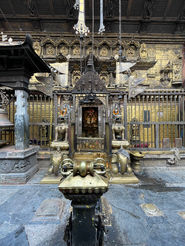
HIRANYA VARNA MAHAVIHARA
Hiranya Varna Mahavihar, or the Kwa Baha- A Buddhist monastery commonly known as the 'Golden Temple of Nepal,' is one of the most extravagantly decorated Bahas in the Kathmandu valley. The valley has been a significant centre of Newar culture and historically a hub for trade and cultural exchange. It is believed that most of the people from the Newar community were wealthy traders in Tibet who used their wealth to decorate and maintain this monastery. While there is no certain evidence of when the Baha was built, some myths suggest that the temple was founded between 1045 and 1048. Due to its proximity to the Patan Durbar square and other historical sites in Patan, the Mahavihara also forms a part of the UNESCO World Heritage List.
The Hiranya Varna Mahavihar projects a configuration similar to most of the monasteries found in Nepal - concentric layers of rooms built around an open courtyard, with the main shrine acting as the nucleus of the complex. The complex also has several smaller shrines and sculptures, each associated with a myth or legend. It begins with the entrance door from the Kwalakhu street, adorned with multiple carvings, where two huge sculptural lions guard the door to keep the evil away. From the entrance, the narrow passage leads to the courtyard, which has the shrine of the Swayambhu Stupa right in the center. Surrounding the courtyard are the common prayer halls and other shrines and temples. While these are accessible to the general public, spaces like the prayer halls for monks and the Agam are kept private. During the annual festivals in August-July, the courtyards are converted into larger community spaces for people to gather and interact.
There are evident typological developments in the monasteries that have often emerged from the mythical tales and common faith of the people. An example of a space created by such legends is the story of the Swayambhu Stupa. According to a legend, the valley of Kathmandu was once a huge lake filled with lotuses. Once, Lord Manjushree saw a bright flame coming from a lotus that seemed to be anchored to a hill. To get a closer look, he cut a gorge near Chobar Hill with a strike of his sword. The water from this lake drained out of this gorge, and the valley of Kathmandu came into existence. (Pant, Samid B, 2022) The place where this lotus settled became the Swayambhu Stupa we see today. Many other stories are associated with different parts of the Mahavihara. These legends have found their way into its spatial forms with multiple translations and still hold an enhanced position of significance within the complex.
References
-
Bhandari, Pukar. 2017. “A report on Architectural Conservation of Dyalko Vagawan, The Golden Temple of Patan and Nag Baha Hiti.” SlideShare. https://www.slideshare.net/slideshow/a-report-on-architectural-conservation-of-dyalko-vagawan-the-golden-temple-of-patan-and-nag-baha-hiti/78899470#25.
-
Hutt, Michael. n.d. Nepal: A guide to art and architecture of Kathmandu valley.
-
Locke, John K. n.d. Buddhist monasteries of Nepal: survey of bahas and bahis of Kathmandu valley.
-
Pant, Samid B. 2022. https://mandalas.life/2022/the-alluring-tales-of-hiranya-varna-mahavihar-gold-colored-great-monastery-also-known-as-the-golden-temple/.
-
Thapa, Dr. Shankar. n.d. “History of Nepalese Buddhism: from mythological tradition to Licchavi period.”

Kwa Baha - The Golden Temple
(Source: Rupali Gupte)

Main Entrance from the street - guarded by the lions
(Source: Rupali Gupte)

Thangka Painting of Lord Manjushree and Lord Ganesh -
The story of the Swayambhu Stupa
(Source: mandalas.life)

Built form around the Temple
(Source: Drawn by Author | After Gyanendra Joshi)






